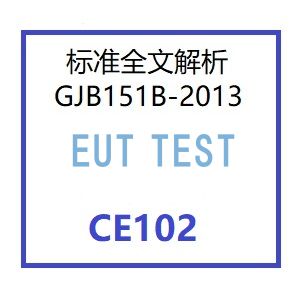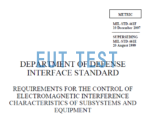CE102 Introduction:
CE102 is required by both GJB151B-2013 and MIL-STD-461F standards for power line conducted emission test items above 10kHz, the biggest difference between CE102 and CE101 is that the test frequency range is different. This article mainly introduces the military EMC standard requirements of CE102 test applicable product range, limit line, the required test equipment, test layout, test methods and procedures and other information, see below for more details about the CE102 10kHz-10MHz power line conducted emission standard analysis of the detailed content.
For more military equipment EMC test items, please see: MIL-STD-461F Standard Requirements for EMC Test Items Introduction.
Scope of application
The CE102 10kHz-10MHz Power Cord Conducted Emission program applies to all equipment power cords, including power return cords. These power cords are powered from an external source other than the EUT.
When the operating current of the EUT is so high that the 50 μH LlSN does not meet the test requirements, the Appendix B EUT Power Port Conducted Emission Substitution Method may be used, subject to the agreement of the ordering party. For high current loads, when the power distribution wiring is short or when there is a dedicated return (as opposed to a structural return) laid along a high level line, etc., the 50 μH-LISN specified for use in CE101 and CE102 may no longer be suitable, and then the 5 μH-LlSN in Appendix B may be used for testing.
CE102 test limits
Conducted emissions from the power cord should not exceed the relevant limits in Figure 14.

Figure 14 CE102 Limits (AC and DC)
CE102 Test Equipment
The test equipment is as follows:
- 20dB Attenuator, 50Ω;
- Measurement receivers;
- current probe;
- signal generator;
- Data logging device;
- oscillographThe input impedance is high resistance;
- Resistors;
- Military LISNThe
CE102 Test Configuration
The test configuration is as follows:
Per GJB151B-2013 How to Select the Correct Test Layout Based on the DUT for Basic Configuration Fig. 2 - Fig. 5 in the diagram.
CE102 Calibration test configuration:
1) Configure as in Figure 15, making sure that power to the LISN input is disconnected (not energized);
2) The measurement receiver is connected to a 20 dB attenuator on the LlSN signal output port.
CE102 EUT Test Configuration
Configured per Figure 16;

Figure 16 CE102 Test Configuration
The measurement receiver is connected to a 20 dB attenuator on the LISN signal output port.
CE102 Test Procedure
For testing, follow the steps below:
The test equipment is energized and warmed up and reaches a stable working condition.
CE102 Calibration Method

Figure 15 CE102 Test System Calibration Configuration
Calibrate the test system according to Figure 15 and the following steps:
- The signal generator outputs signals to the LISN power supply outputs at 10kHz, 100kHz, 2MHz, and 10MHz at levels at least 6dB below the limits. at 10kHz and 100kHz. use an oscilloscope to confirm that it is a sinusoidal waveform and measure the signal RMS level. At 2MHz and 10MHz use the signal level directly from the 50Ω signal generator output.
- Note: The input impedance can be either 50Ω or high resistance when measured with an oscilloscope at 10kHz and 100kHz.
- The measurement receiver was scanned in the normal data scanning manner to confirm that the measurements were within ±3 dB of the injected signal level. The correction factor includes the 20 dB attenuator, the insertion loss of the 0.25 μF coupling capacitor in the LISN (see Figure 6).
- If the measured value deviates by more than ±3 dB, identify the cause of the error and correct it before testing.
- Repeat the above steps separately for each of the other LISNs.
CE102 EUT Test Method
Scan the EUT power line for conducted emission data per the Figure 16 CE102 test configuration referenced above and the following steps:
- The EUT is energized to warm up and reach a stable operating state;
- Select a power cord to test;
- The measurement receiver sets the bandwidth and measurement time according to Table 2 and scans over the applicable frequency range;
- Repeat the above steps for each of the other power cords under test.
Test data and reporting requirements:
Upon completion of the test, the following test data is required:
a) Plot the spectrum of the test data continuously and automatically on the X-Y coordinates;
b) The applicable limit curves are shown on the graph;
c) List the required frequency, amplitude, and amount of exceedance of limits and their operating status.


